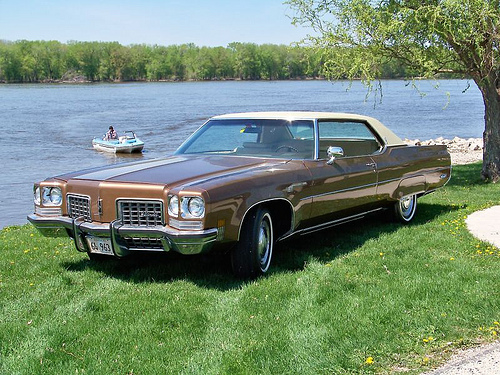Among the cars in Texas enthusiast Don Davis’s great collection, which will all be sold ‘without reserve’ by RM Auctions on April 27, 2013, there are plenty of big and beautiful American machines. Most are incredibly rare and all are spotless, but the red lettering down the sides of one particular car draws the eyes immediately. Perhaps it is appropriate that our eyes should follow Davis’s 1941 Chrysler Newport. It did, after all, serve as the pace car in the Indianapolis 500.
With the dual blows of the Great Depression and the slightly less disastrous Airflow, Chrysler spent the late-1930s building conservatively designed and engineered automobiles. But designer Ralph Roberts of LeBaron recognized that as the nation and the company recovered, Chrysler would benefit from some the addition of some high style to its lineup.
What Roberts had in mind was a dual cowl phaeton, a body style that had disappeared from Chryslers after 1933. For the dual cowl’s revival, he combined the old-fashioned body style with exotic baroque curves inspired by aircraft design, including flowing envelope fenders, a fully disappearing fabric top, and headlights that disappeared behind flush-fitting retractable covers. Even the rear cowl was electronically raised and lowered, to ease passenger entry and exit. The result, dubbed the Newport, was so striking that it moved even Chrysler chief K.T. Keller, a known proponent of conservative design.
Keller ordered LeBaron to produce six examples of the Newport for the 1941 auto shows, which, by the time of the order, meant that all six cars had to be turned out in 90 days. It is believed that only five were actually completed, and they caused a sensation as they toured auto shows and Chrysler dealerships in the months before World War II. Despite their “concept car” status, the Newports have enjoyed an enviable survival rate. All five remain today, including examples held in the permanent collections of the Walter P. Chrysler Museum and the National Automobile Museum.
The car shown here was the only Newport built with open headlights, giving it a unique front-end appearance. It is also, perhaps, the most famous example, having served as the Pacemaker of the 1941 Indianapolis 500, the last one held before World War II. Period footage of the race survives at the Indianapolis Motor Speedway Hall of Fame, clearly showing this Newport, with its distinctive open headlights, leading the field around the Brickyard. Interestingly, the Newport was, up to that time, the only non-production automobile to have ever paced at Indianapolis. This did not happen again until the Dodge Viper prototype ran in 1989, and the Newport remains the last custom-bodied automobile to have paced Indianapolis.
It was common in this relaxed era for auto industry executives to commandeer unique prototypes for their personal use. In the case of the Pacemaker Newport, it passed into the hands of Walter P. Chrysler Jr., son of the company’s late founder and namesake, who had it repainted light green and used it while vacationing on Cape Cod. The car was eventually traded into a Chevrolet dealer in Provincetown, Massachusetts, probably by the second owner. It was stored by the next owner in his barn for 30 years, before being sold in July 1989 to A.J. “Tony” Pascucci and his son John, noted collectors who revealed it to the enthusiast community after decades of hiding.
It then passed through the hands of prominent collectors Jim Kaufmann and Roger Willbanks. In Willbanks’ hands, the Newport, repainted Chrysler’s green and with the Pacemaker lettering reapplied, appeared at the Pebble Beach Concours d’Elegance in 2003. Appropriately, it was chosen that same weekend to pace the course, this time at the Monterey Historic races at the Laguna Seca Raceway.
The Newport was next acquired by a Texas collector, whose shop restored it to its original appearance, including the correct bronze finish it had worn at Indy. The restoration took thousands of man hours to complete, with no area of the car untouched. Passed not long after into the hands of Mr. Don Davis, the Pacemaker has resided with him since, and it has been maintained in concours condition and stands today as well as it did in 1941.
This 1941 Chrysler Newport is available at the upcoming RM Auctions Don Davis Collection sale, scheduled for April 27, 2013 in Fort Worth, Texas. It carries a pre-sale estimate of $900,000 to $1,200,000.
Entre los coches de gran colección de Tejas entusiasta de Don Davis, que todo ser vendido "sin reservas" por RM Auctions el 27 de abril de 2013, hay un montón de grandes y hermosas máquinas americanas. La mayoría son muy raros y todos son impecables, pero la letras rojas a los lados de un vehículo particular, dibuja de inmediato los ojos. Tal vez sea conveniente que nuestros ojos deben seguir la Davis 1941 Chrysler Newport. No tenía, después de todo, servir como el coche de seguridad en la Indianapolis 500.
Unter den Autos in große Sammlung Texas Enthusiasten Don Davis ', die alle verkauft werden, "ohne Reserve" werden von RM Auctions am 27. April 2013, gibt es viele große und schöne amerikanischen Maschinen. Die meisten sind unglaublich selten und alle sind makellos, aber der rote Schriftzug an den Seiten von einem bestimmten Auto zieht die Augen sofort. Vielleicht ist es angemessen, dass unsere Augen sollte Davis 1941 Chrysler Newport folgen. Es dauerte immerhin als Pace Car in der Indianapolis 500 zu dienen.
汽车在德州爱好者唐戴维斯的伟大的收集,所有出售的“毫无保留”的RM拍卖2013年4月27,也有很多又大又漂亮的美国机。大多数是令人难以置信的罕见的,都是一尘不染的,但一个特定的汽车两侧的红色刻字下来立即吸引眼睛。也许是适当的,我们的眼睛应该遵循1941年戴维斯的克莱斯勒新港。它没有,毕竟,作为在印第安纳波利斯500汽车的步伐。

















.jpg)





















